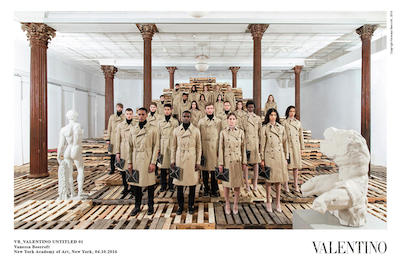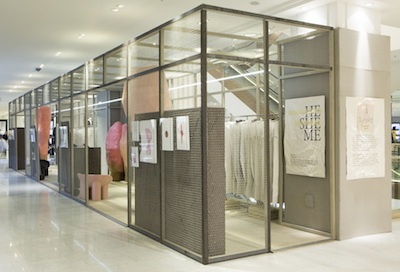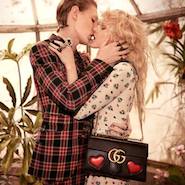Luxury fashion labels are breaking with tradition, bending the rules of gendered dressing through their designs and marketing.
From co-ed fashion shows and unisex collections to cross dressing in campaigns, brands are incorporating themselves into the larger conversation around gender identity. While androgyny has infiltrated the fashion industry as a whole, is this unisex approach an effective strategy for heritage luxury labels?
“While there is certainly more designers who are launching unisex collections, there were those who were conceived around gender ambiguous clothes – think Margiela, Rick Owens, Thom Browne, J.W. Anderson,” said Ana Andjelic, senior vice president and global strategy director at Havas LuxHub. “Céline always opted more for self-expression and experimentation over gender.
“Today, Vetements, Off White and Gosha Rubchinskiy. To a great extent, that’s what street fashion is and always have been: there’s a certain freedom to experiment that traditionally was not present in the high-end fashion,” she said. “In terms of behaviors of those fashion-forward consumers who are defining the fashion zeitgeist today, they will buy items they like, regardless of how those items are categorized.
“It’s all about doing what you want, looking the way you want, and breaking the rules. It should not come as a surprise if this rule-breaking has gotten commercialized.”
Coming together
Valentino’s creative directors Maria Grazia Chiuri and Pierpaolo Piccioli recently got back to basics with a gender-neutral line of classic pieces. Rockstud Untitled is a unisex capsule consisting of wardrobe staples including a trench coat, crew neck sweater, white shirt and peacoat (see story).

Valentino Rockstud Untitled collection
Ferragamo also mused on the unisex dressing trends of today with a capsule collection of off-duty attire (see story).
Designers are also playing off the convergence of menswear and women’s wear at their fashion shows.
Gucci recently announced that its runway shows would no longer be segregated by gender. The label’s creative director Alessandro Michele has frequently played with gender norms on the runway, putting details typically reserved for women’s apparel on men’s shirts, such as lurex, ruffles and pussycat bows.
“Within the luxury industry, unisex dressing allows for both genders to enjoy an array of styles and colors that allows guys and girls to dress in the way that reflects them,” said Kimmie Smith, co-founder/creative director of Accessory2 and co-founder/style director of Athleisure Mag. “In addition, unisex takes the guess work out of how a garment falls on the body especially for those that may have slimmer bodies. It also allows brands to test a number of products so that they can see what may work well in one gender versus another or to maintain it within a combined line.
“Unisex trends allow an equalization in fashion that means that certain colors and styles are not designated by sex,” she said. “It is something that has been seen within an array of brands but within luxury it allows those companies to pinpoint who their customer is a bit better whether it’s within apparel, shoes and additional accessories.
“I believe that this will continue to be within the lexicon of brands as the interest in having this will continue to gain steam.”
Since Mr. Michele was promoted to his leadership position, Gucci has frequently included both men and women in the same runway show, making a more official move toward co-ed catwalks a logical next step.
Bottega Veneta announced this spring that it will be hosting a combined men’s and women’s runway show for the spring/summer 2017 season during Milan Fashion Week this fall.
Taking note of the increasing convergence between men’s and women’s styles, Selfridges launched “Agender,” a multichannel campaign that included the launch of a gender-neutral shopping area at its Oxford Street flagship store. This initiative, launched last spring, was intended to break down barriers between genders and start a conversation (see story).

Selfridges’ Agender in-store selection
Labels have experimented in marketing, placing campaign faces in apparel originally intended for the opposite sex.
Jaden Smith donned a look from Louis Vuitton’s spring/summer 2016 women’s runway show in the brand’s campaign for the season, appearing alongside female models. Similarly, Fendi casting Amanda Harlech as the lead in a narrative campaign surrounding its fall/winter 2015 menswear collection.
“Unisex is here to stay,” Ms. Andjelic said. “To a certain extent, it has lasted for the past 20 plus years, ever since the Antwerp Six started changing the rules of high-end fashion. It’s always been there.
“Now it’s more widespread. Kanye [West] wore Céline at his concert couple of years ago; his collections are super-unisex,” she said. “There are more social, cultural and economic conversations about transgender identity, same-sex marriage and female leadership.”
Some brands are not buying into today’s more fluid gender lines. In an interview with WWD, Sidney Toledano, CEO of Dior, said that at its label, the men remain very masculine and the women feminine.
For those that take a unisex approach, it may be best left to special capsules. Gender neutral styles may appease consumers for a time, but eventually they are likely to demand merchandise designed specifically for their needs.
For instance, women became fans of leather goods maker Ghurka through its men’s and unisex styles of bags, since it did not have a women’s collection. However, even while they were snatching up more masculine styles, they were voicing their interest in a women’s line, leading the brand to create its first women’s collection in more than 15 years (see story).
“Today’s fashion consumer looks for ammunition for their lifestyle, regardless of where this ammunition comes from,” Ms. Andjelic said. “A brand with a distinct lifestyle concept, which is reflected both in menswear and womenswear, has a greater chances for attracting its audience and increasing its profits.
“The underlying advantages of having a strong point of view are decreased commoditization of their products, relevance outside and beyond fashion cycles, and creative economic outcomes in the form of new ideas and new business opportunities,” she said. “It’s about having a strong idea that can be reflected in both genders – or in a single, unisex direction. Those smart brands sell the same item to two audiences, thus doubling up their production, distribution, merchandising and marketing ROI and halving their costs.”
Larger trend
Unisex design is not limited to fashion labels.
In 2014, Switzerland’s IWC Schaffhausen debuted a timepiece collection geared toward both men and women to reflect current horology trends.
IWC’s Portofino Midsize collection was a first for the watchmaker, which acknowledges that oftentimes the timepiece industry is predominantly skewed toward a male consumer base. The Portofino Midsize collection looked to amend that habit by appealing to the demand of both sexes for a smaller case diameter with a celebrity-studded campaign and wide style options (see story).
Also, male-focused accessories maker William Henry is hoping to broaden its market by asking what #ARealManIs.
In a humorous music video, a group of men break down stereotypes of how men are expected to act, implicitly suggesting that men shouldn’t be afraid to wear the brand’s jewelry. Gender fluidity has penetrated the luxury world, and William Henry’s effort is the latest to embrace newfound individuality (see story).
“Each brand will have to look at their customer base to see what makes sense for them in terms of how much of their collections will focus within this area and whether this will be a mainstay within the line,” Ms. Smith said.
“There are ways for each brand to incorporate the heritage and history within this fluidity in an authentic way depending on the needs of their base,” she said. “Presenting these concepts will provide brands a freedom from marketing these items, how it is presented as well as when it’s advertised through an array of markets.
“Each brand will have to look at what this means to their brand. Those who have products for men and women will be able to dip a toe into this easier by playing with their assortments. It will truly require brands to analyze their customers and how they receive the products in order to make the best decisions to push the envelope for how they will include this within the brand.”
from
http://redirect.viglink.com?u=http%3A%2F%2Fredirect.viglink.com%2F%3Fu%3Dhttps%253A%252F%252Fwww.luxurydaily.com%252Fluxury-labels-embrace-androgyny-with-gender-neutral-initiatives%252F%26key%3Dddaed8f51db7bb1330a6f6de768a69b8&key=ddaed8f51db7bb1330a6f6de768a69b8

No comments:
Post a Comment